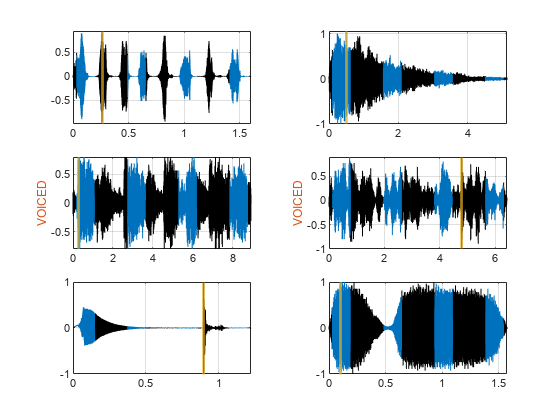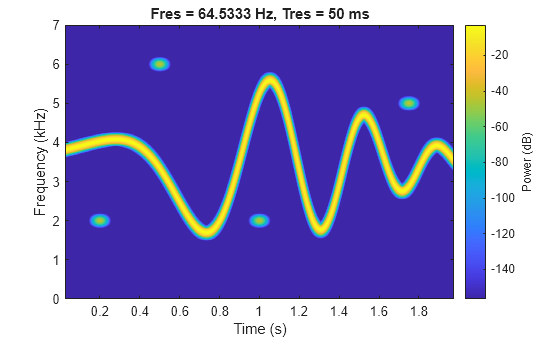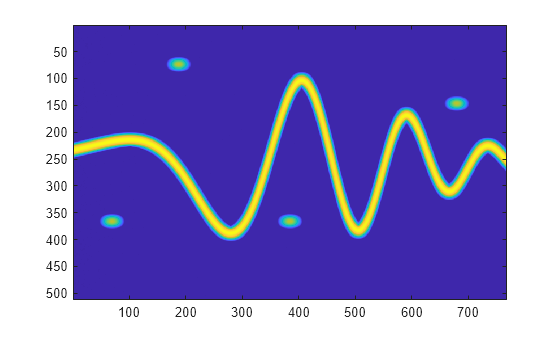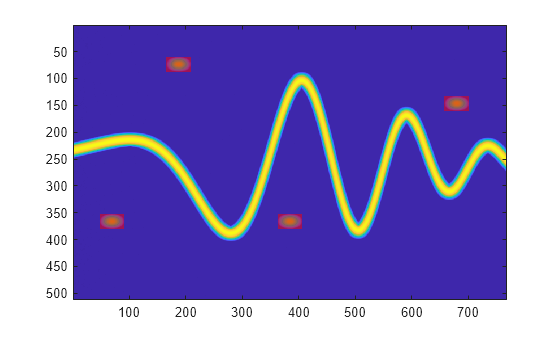createDatastores
Syntax
Description
[
creates the datastores sigData,lblData] = createDatastores(lss,lblNames)sigData and lblData
containing signal member data and label data.
The
createDatastoresfunction creates the datastores from the labeled signal setlssand labels specified inlblNames.createDatastoresdoes not apply to sublabels. SetlblNamesto one or more parent label names to get the parent labels and the corresponding sublabel values.
[
specifies additional options using name-value arguments.sigData,lblData] = createDatastores(lss,lblNames,Name=Value)
You must specify
roiTimeFrequencylabel definitions inlblNamesto use this syntax. To see which label definitions areroiTimeFrequencyin a labeled signal setlss, typegetLabelDefinitions(lss,LabelType="roiTimeFrequency").You can specify multiple name-value arguments. For example,
creates datastores from the labeled signal set[sigData,lblData] = createDatastores(lss,"Atom", ... TimeFrequencyMapFormat="image",TimeFrequencyLabelFormat="mask")lssand time-frequency ROI label definition"Atom". ThecreateDatastoresfunction returns the time-frequency map image insigDataand the ROI time-frequency label mask inlblData.
(since R2025a)
Examples
Load a labeled signal set containing recordings of whale songs.
load whales
lsslss =
labeledSignalSet with properties:
Source: {2×1 cell}
NumMembers: 2
TimeInformation: "sampleRate"
SampleRate: 4000
Labels: [2×3 table]
Description: "Characterize wave song regions"
Use labelDefinitionsHierarchy to see a list of labels and sublabels.
Use setLabelValue to add data to the set.
Display the labels for the first member of the set.
lss.Labels(1,:)
ans=1×3 table
WhaleType MoanRegions TrillRegions
_________ ___________ ____________
Member{1} blue {3×2 table} {1×3 table}
Get the names of the labels in the set. Create a signal datastore with the signal information and an array datastore with the label information.
lbls = getLabelNames(lss); [sgd,lbd] = createDatastores(lss,lbls)
sgd =
signalDatastore with properties:
MemberNames:{
'Member{1}';
'Member{2}'
}
Members: {2×1 cell}
ReadSize: 1
SampleRate: 4000
OutputDataType: "same"
OutputEnvironment: "cpu"
lbd =
ArrayDatastore with properties:
ReadSize: 1
IterationDimension: 1
OutputType: "cell"
Display the labels for the first member of the set.
lbls = read(lbd);
lbls{:}ans=1×3 table
WhaleType MoanRegions TrillRegions
_________ ___________ ____________
blue {3×2 table} {1×3 table}
Specify the path to a set of audio signals included as MAT files with MATLAB®. Each file contains a signal variable and a sample rate. List the names of the files.
folder = fullfile(matlabroot,"toolbox","matlab","audiovideo"); lst = dir(append(folder,"/*.mat")); nms = {lst(:).name}'
nms = 7×1 cell
{'chirp.mat' }
{'gong.mat' }
{'handel.mat' }
{'laughter.mat'}
{'mtlb.mat' }
{'splat.mat' }
{'train.mat' }
Create a signal datastore that points to the specified folder. Set the sample rate variable name to Fs, which is common to all files. Generate a subset of the datastore that excludes the file mtlb.mat. Use the subset datastore as the source for a labeledSignalSet object.
sds = signalDatastore(folder,SampleRateVariableName="Fs"); sds = subset(sds,~strcmp(nms,"mtlb.mat")); lss = labeledSignalSet(sds);
Create three label definitions to label the signals:
Define a logical attribute label that is true for signals that contain human voices.
Define a numeric point label that marks the location and amplitude of the maximum of each signal.
Define a categorical region-of-interest (ROI) label to pick out nonoverlapping, uniform-length random regions of each signal.
Add the signal label definitions to the labeled signal set.
vc = signalLabelDefinition("Voice",LabelType="attribute", ... LabelDataType="logical",DefaultValue=false); mx = signalLabelDefinition("Maximum",LabelType="point", ... LabelDataType="numeric"); rs = signalLabelDefinition("RanROI",LabelType="ROI", ... LabelDataType="categorical",Categories=["ROI" "other"]); addLabelDefinitions(lss,[vc mx rs])
Label the signals:
Label
'handel.mat'and'laughter.mat'as having human voices.Use the
islocalmaxfunction to find the maximum of each signal. Label its location and value.Use the
randROIfunction to generate as many regions of length N/10 samples as can fit in a signal of length N given a minimum separation of N/6 samples between regions. Label their locations and assign them to theROIcategory.
When labeling points and regions, convert sample values to time values. Subtract 1 to account for MATLAB array indexing and divide by the sample rate.
kj = 1; while hasdata(sds) [sig,info] = read(sds); fs = info.SampleRate; [~,fn] = fileparts(info.FileName); if fn=="handel" || fn=="laughter" setLabelValue(lss,kj,"Voice",true) end xm = find(islocalmax(sig,MaxNumExtrema=1)); setLabelValue(lss,kj,"Maximum",(xm-1)/fs,sig(xm)) N = length(sig); rois = randROI(N,round(N/10),round(N/6)); setLabelValue(lss,kj,"RanROI",(rois-1)/fs, ... repelem("ROI",size(rois,1))) kj = kj+1; end
Verify that only two signals contain voices.
countLabelValues(lss,"Voice")ans=2×3 table
Voice Count Percent
_____ _____ _______
false 4 66.667
true 2 33.333
Verify that two signals have a maximum amplitude of 1.
countLabelValues(lss,"Maximum")ans=5×4 table
Maximum Count Percent MemberCount
______________________ _____ _______ ___________
0.80000000000000004441 1 16.667 1
0.89113331915798421612 1 16.667 1
0.94730769230769229505 1 16.667 1
1 2 33.333 2
1.0575668990330560071 1 16.667 1
Verify that each signal has four nonoverlapping random regions of interest.
countLabelValues(lss,"RanROI")ans=2×4 table
RanROI Count Percent MemberCount
______ _____ _______ ___________
ROI 24 100 6
other 0 0 0
Create two datastores with the data in the labeled signal set:
The
signalDatastore(Signal Processing Toolbox) objectsdcontains the signal data.The
arrayDatastoreobjectldcontains the labeling information. Specify that you want to include the information corresponding to all the labels you created.
[sd,ld] = createDatastores(lss,["Voice" "RanROI" "Maximum"]);
Use the information in the datastores to plot the signals and display their labels.
Use a
signalMask(Signal Processing Toolbox) object to highlight the regions of interest in blue.Plot yellow lines to mark the locations of the maxima.
Add a red axis label to the signals that contain human voices.
tiledlayout flow while hasdata(sd) [sg,nf] = read(sd); lbls = read(ld); nexttile msk = signalMask(lbls{:}.RanROI{:},SampleRate=nf.SampleRate); plotsigroi(msk,sg) colorbar off xlabel('') xline(lbls{:}.Maximum{:}.Location, ... LineWidth=2,Color="#EDB120") if lbls{:}.Voice{:} ylabel("VOICED",Color="#D95319") end end

function roilims = randROI(N,wid,sep) num = floor((N+sep)/(wid+sep)); hq = histcounts(randi(num+1,1,N-num*wid-(num-1)*sep),(1:num+2)-1/2); roilims = (1 + (0:num-1)*(wid+sep) + cumsum(hq(1:num)))' + [0 wid-1]; end
Since R2025a
Label Gaussian atoms in the time-frequency domain using a time-frequency region-of-interest (ROI) label definition and spectrogram options.
Generate Signal and Visualize Spectrogram
Generate a signal that consists of a voltage-controlled oscillator and four Gaussian atoms. The signal is sampled at 14 kHz for two seconds. Plot the spectrogram of the signal.
Fs = 14000; t = (0:1/Fs:2)'; st = 0.01; gaussFun = @(A,x,mu,f) exp(-(x-mu).^2/(2*st^2)).*sin(2*pi*f.*x)*A'; atomTimeCenters = [0.2 0.5 1 1.75]; atomFreqCenters = [2 6 2 5]*1000; s = gaussFun([1 1 1 1]/10,t,atomTimeCenters,atomFreqCenters); x = vco(chirp(t+.1,0,t(end),3).*exp(-2*(t-1).^2),[0.1 0.4]*Fs,Fs); s = s/10+x; bt = 0.2; tr = 0.05; op = 99; pspectrum(s,Fs,"spectrogram", ... Leakage=bt,TimeResolution=tr,OverlapPercent=op)

The spectrogram shows four patches in time-frequency domain that correspond with the Gaussian atoms. Define the times and frequencies for all the atoms.
atomTimes = atomTimeCenters'+[-st st]*5.5; atomFreqs = atomFreqCenters'+[-1 1]*200;
Label Signal in Time-Frequency Domain
Create a logical time-frequency ROI label definition to label the Gaussian atoms. Specify spectrogram options with leakage properties.
opts = labelSpectrogramOptions("leakage", ... Leakage=40*(1-bt),Overlap=op, ... TimeResolutionMode="specify",TimeResolution=tr); lblDef = signalLabelDefinition("Atom", ... LabelDataType="logical", ... LabelType="roiTimeFrequency",TimeFrequencyOptions=opts);
Create a labeled signal set from the signal and time-frequency ROI label definition.
lss = labeledSignalSet(s,lblDef,SampleRate=Fs);
Label the four atoms in time-frequency domain. Set the label values to true.
setLabelValue(lss,1,"Atom",atomTimes,atomFreqs,true(1,4))Visualize Time-Frequency Image and Label Mask
Create datastores from the labeled signal set for the time-frequency ROI label.
imSize = [512 768]; [sds,ads] = createDatastores(lss,"Atom", ... TimeFrequencyMapFormat="image", ... TimeFrequencyImageSize=imSize, ... TimeFrequencyLabelFormat="mask", ... TimeFrequencyMaskPriority=true);
Read and show the time-frequency image.
imagesc(read(sds))

Read the label mask and display it above the time-frequency image.
lbl = read(ads);
im = zeros([imSize 3]);
im(:,:,1) = lbl{1};
hold on
imagesc(im,AlphaData=0.5*lbl{1})
hold off
Input Arguments
Labeled signal set, specified as a labeledSignalSet
object.
Example: labeledSignalSet({randn(100,1)
randn(10,1)},signalLabelDefinition("female"))"female".
Label names, specified as a character vector, a string scalar, a cell array of character vectors, or a string array.
Data Types: char | string
Name-Value Arguments
Specify optional pairs of arguments as
Name1=Value1,...,NameN=ValueN, where Name is
the argument name and Value is the corresponding value.
Name-value arguments must appear after other arguments, but the order of the
pairs does not matter.
Example: [sds,ads] =
createDatastores(lss,"Atom",TimeFrequencyMapFormat="image",TimeFrequencyLabelFormat="mask")
creates datastores from the labeled signal set lss and time-frequency ROI
label definition "Atom". The createDatastores function
returns the time-frequency map image in sds and the ROI time-frequency
label mask in ads.
Format of time-frequency map, specified as one of these values:
"map"—createDatastoresstores the member signals as M-by-N matrices, where M is the number of frequency bins and N is the number of time windows. Each matrix represents the grayscale map of the spectrogram magnitude in dB."image"—createDatastoresstores the member signals as M-by-N-by-3 arrays, where M is the number of frequency bins and N is the number of time windows. Each array represents an image of the spectrogram magnitude in dB. The third dimension of each array represents the color intensity in red, green, and blue.
When you specify TimeFrequencyMapFormat,
createDatastores returns sigData as a TransformedDatastore
object with one of the format options. The function chooses M and
N automatically unless you specify these dimensions in
TimeFrequencyImageSize.
To use this input argument, you must specify roiTimeFrequency
label definitions in lblNames.
Data Types: char | string
Size of time-frequency image, specified as a two-element vector of positive integers.
When you specify TimeFrequencyImageSize as a vector
[M
N], createDatastores sets
TimeFrequencyMapFormat as "image" and stores
the member signals as M-by-N-by-3 arrays, where
M is the number of frequency bins and N is the
number of time windows. Each array represents an image of the spectrogram magnitude in
dB. The third dimension of each array represents the color intensity in red, green,
and blue.
To use this input argument, you must specify roiTimeFrequency
label definitions in lblNames.
Data Types: double | single
Format of time-frequency label, specified as one of these values:
"mask"—createDatastoresstores the labels of the member signals as M-by-N matrices, where M is the number of frequency bins and N is the number of time windows. Each value in each matrix represents the label value at the same indices as the corresponding signal time-frequency map."xywh"—createDatastoresstores the labels of the member signals as four-element vectors [x y w h] describing each instance of the label value, where:x represents the starting column of the label matrix.
y represents the starting row of the label matrix
w indicates how many columns the label spans across.
h indicates how many rows the label spans across.
"xyMinMax"—createDatastoresstores the labels of the member signals as four-element vectors [xMin xMax yMin yMax] describing each instance of the label value, where:xMin represents the minimum x value in the x-axis units of the time-frequency map.
xMax represents the maximum x value in the x-axis units of the time-frequency map.
yMin represents the minimum y value in the y-axis units of the time-frequency map.
yMax represents the maximum y value in the y-axis units of the time-frequency map.
When you specify TimeFrequencyMapFormat, the function returns
lblData as an arrayDatastore object with one of the format options.
To use this input argument, you must specify roiTimeFrequency
label definitions in lblNames.
Data Types: char | string
Mask priority of time-frequency map, specified as true,
false, "ascending",
"descending", a vector of strings, or a cell array of character
vectors. TimeFrequencyMaskPriority specifies the hierarchy of
overlapping labels.
Specify a value for TimeFrequencyMaskPriority depending on
the label data type of the labeled signal set specified in lss.
If
lss.LabelDataTypeis"logical", specifyTimeFrequencyMaskPriorityas one of these values:true— The function assigns priority to labels with value of"true"over labels with value"false".false— The function assigns priority to labels with value of"false"over labels with value"true".
If
lss.LabelDataTypeis"numeric", specifyTimeFrequencyMaskPriorityas one of these values:"ascending"— The function assigns priority to labels with lower numeric values over labels with higher numeric values."descending"— The function assigns priority to labels with higher numeric values over labels with lower numeric values.
If
lss.LabelDataTypeis"categorical", specifyTimeFrequencyMaskPriorityas a vector of strings or cell array of character vectors that includes the entire set of categorical values for the label definition. This vector or array specifies the order of priority, with the first category having highest priority.If
lss.LabelDataTypeis"string", specifyTimeFrequencyMaskPriorityas one of these values:"ascending"— The function assigns priority to labels with lower alphabetical ordering over labels with higher alphabetical ordering."descending"— The function assigns priority to labels with higher alphabetical ordering over labels with lower alphabetical ordering.
To use this input argument, you must:
Specify
"roiTimeFrequency"label definitions inlblNames.Set
TimeFrequencyLabelFormatto"mask".
Data Types: char | string | logical
Option to include partial bins in the time-frequency map, specified as
1 (true) or 0
(false). When you specify
TimeFrequencyIncludePartialBins,
createDatastores determines if the pixels in the time-frequency map
must include an entire time and frequency bin.
To use this input argument, you must specify roiTimeFrequency
label definitions in lblNames.
Data Types: double | single | logical
Output Arguments
Signal data, returned as a signalDatastore (Signal Processing Toolbox) object, an audioDatastore (Audio Toolbox)
object, or a TransformedDatastore
object.
Label data, returned as an arrayDatastore object.
Version History
Introduced in R2021aThe createDatastores function supports labeled signal sets with
roiTimeFrequency label definitions. The function also enables you to
save time-frequency maps and labels in datastore objects.
See Also
MATLAB Command
You clicked a link that corresponds to this MATLAB command:
Run the command by entering it in the MATLAB Command Window. Web browsers do not support MATLAB commands.
Select a Web Site
Choose a web site to get translated content where available and see local events and offers. Based on your location, we recommend that you select: .
You can also select a web site from the following list
How to Get Best Site Performance
Select the China site (in Chinese or English) for best site performance. Other MathWorks country sites are not optimized for visits from your location.
Americas
- América Latina (Español)
- Canada (English)
- United States (English)
Europe
- Belgium (English)
- Denmark (English)
- Deutschland (Deutsch)
- España (Español)
- Finland (English)
- France (Français)
- Ireland (English)
- Italia (Italiano)
- Luxembourg (English)
- Netherlands (English)
- Norway (English)
- Österreich (Deutsch)
- Portugal (English)
- Sweden (English)
- Switzerland
- United Kingdom (English)